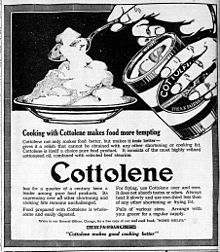
Cottolene was a brand of shortening made of beef suet and cottonseed oil produced in the United States from the late 1880s until the mid-20th century. It was the first mass-produced and mass-marketed alternative to cooking with lard, and is remembered today for its iconic national ad campaign and the cookbooks that were written to promote its use.
History
Background
The concept for Cottolene emerged as an offshoot of two industries. Cotton seeds were a high oil-content waste product of the cotton industry, and beef tallow was a waste product of the meat-processing industry. N. K. Fairbank Co. of Chicago seized upon this glut and created a product catering to late-19th-century Americans' growing infatuation with labor-saving packaged foods for the "dainty" (or "lard-free") diet (according to Dr. Alice Ross, writing in the Journal of Antiques and Collectibles.)
Development and features
Techniques employing nickel-based alloys used in the isolation and removal of consumable hydrogenated vegetable oils from plants, especially cottonseed, were pioneered by the efforts of Fairbank chemist James F. Boyce. Incorporating these advances into the limited cooking oils market at the time resulted in the creation of Cottolene, a product containing 90% vegetable fat. This quickly became a popular culinary replacement for cooking butters and lard, substances that had been used in kitchens for centuries and known to be unhealthy.
Cottolene imparted no additional strong flavors when used in food preparation, and was marketed as purer and more natural than lard. The shortening dominated the vegetable cooking oil market until competitor Procter & Gamble unveiled Crisco in the early-20th-century. Packaged similarly in metal pails—and also marketed with accompanying cookbooks—Crisco was composed entirely of vegetable oils, and became the preferred brand found in many kitchens of the day.
Marketing impact
Cottolene remains in the public consciousness, in part thanks to the lasting impact of its advertising campaign and the accompanying cookbooks it produced. A September 2007 search of the auction website eBay revealed 29 separate Cottolene advertisements and tins for sale. At least one Cottolene cookbook, Fifty-Two Sunday Dinners by Elizabeth O. Hiller, was reprinted in its entirety in 1981, with all references to Cottolene intact, both in the opening endorsements and the following recipes.
References
- ^ Ross, Alice (February 2002). "Cottolene and the Mysterious Disappearance of Lard". Journal of Antiques and Collectibles.
- Cottolene Ad; Cottolene Shortening; Vintage Ads; retrieved October 2022
- Cottolene, Advertising, Exonumia items on eBay.com Archived January 2, 2007, at the Wayback Machine
- Hiller, Elizabeth O. (1913). Fifty-two Sunday dinners : a book of recipes, arranged on a unique plan, combining helpful suggestions for appetizing, well-balanced menus, with all the latest discoveries in the preparation of tasty, wholesome cookery. Cornell University Library. Chicago : N. K. Fairbank Co.
Further reading
- Bernstein, Robin; Racial Innocence: Performing American Childhood from Slavery to Civil Rights,; New York: New York University Press, (2011), pp. 30–36, 64-65; presents scholarly analysis of Cottolene advertisements.